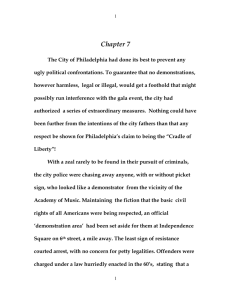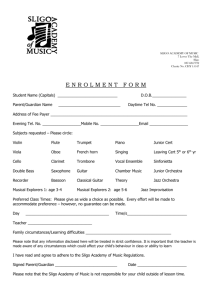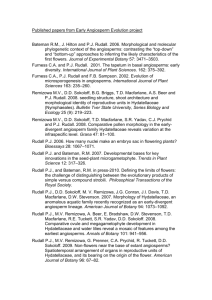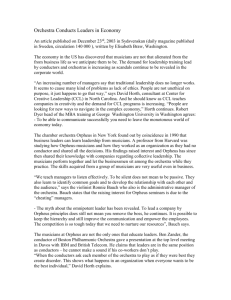docx - Ferment Magazine
advertisement
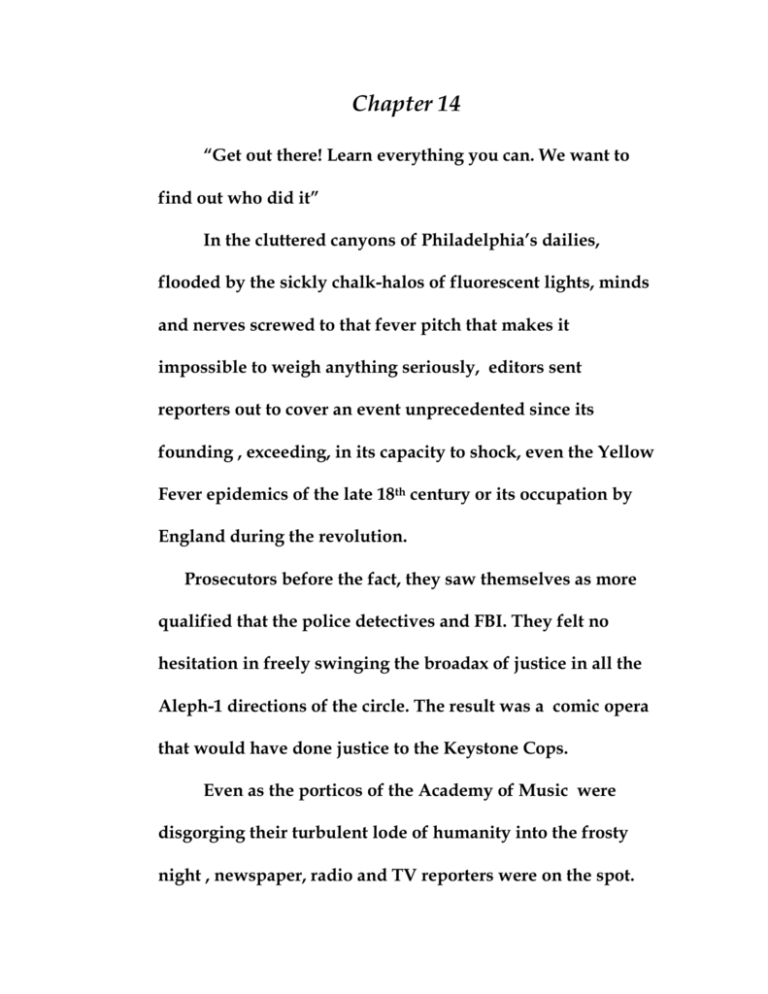
Chapter 14 “Get out there! Learn everything you can. We want to find out who did it” In the cluttered canyons of Philadelphia’s dailies, flooded by the sickly chalk-halos of fluorescent lights, minds and nerves screwed to that fever pitch that makes it impossible to weigh anything seriously, editors sent reporters out to cover an event unprecedented since its founding , exceeding, in its capacity to shock, even the Yellow Fever epidemics of the late 18th century or its occupation by England during the revolution. Prosecutors before the fact, they saw themselves as more qualified that the police detectives and FBI. They felt no hesitation in freely swinging the broadax of justice in all the Aleph-1 directions of the circle. The result was a comic opera that would have done justice to the Keystone Cops. Even as the porticos of the Academy of Music were disgorging their turbulent lode of humanity into the frosty night , newspaper, radio and TV reporters were on the spot. Half a dozen senior members of the journalist herd grappled with the Secret Service, the Praetorian Guard of Hernando Guzman as they struggled to get him into his limousine, and themselves into their own sleek black vans . Driven by animal instincts of curiosity and competitiveness, the (lets not call them “paparazzi”!) honorable delegates of the 5th estate clambered over the roof of the governor’s limousine and thrust their mikes through its windows: “Who’s the bad guys , guv? Come on, you know who did it! Commies, wasn’t it? ” “Maniacs! Terrorists”, Guzman swore, “Castroists!” Other reporters of lesser athletic prowess, but equal in staying power blocked the entrances of the local hospitals. They were kicked in the shins by irritated orderlies; ordered about by arrogant and exhausted interns; they had their faces scratched by victims of shock and ejected from ER’s by over-worked doctors. They held on. “What’s your opinion, guy? Who did it?” “It had to be political, didn’t it? Huh? Is that what you think?” “It had to be those Puerto Rican terrorists, didn’t it? Or you think maybe the Croatians did it? What about the IRA?” “Hippies? Druggies? Fascists?” “Look lady, I know your ribs are cracked and you’re in pain. Just tell us what happened, okay?” Everything was speculation, conjecture, surmise; most often it was dogmatic surmise. Quite a number imagined that the stampede had been initiated when Patricia Augusta-Holmes fell out of her box; some were convinced they’d seen her being thrown out of the box by a mad-man (woman) . The conviction in the voices of those who asserted that a bomb had actually exploded on the stage of the Academy was extraordinary, to say the least. Yet the majority firmly believed that it was the work of Puerto Rican terrorists. “They told everybody they were going to do it!” “Sir, who do you mean by ‘they’?” “You know – the ones that were throwing rocks and bottles before the concert! The Helga ..whatever!” “I knew something bad was going to happen the moment I saw their picket signs!” “ Alice, why did you listen to our son? Didn’t I tell you we shouldn’t go?” “Why did the great Casals decide to live with those kinds of people? That’s something I’ll never understand.” “Invade the island! Send in the Marines!” “Invade the whole Caribbean! Make it all ours! America will never be safe until we do!” “Musicians have never hurt anybody. Why do they pick on us?” Brief and to the point were denunciations such as: “Communists!” “Atheists!” “Spanish Fascists!” A columnist writing for Worker’s World was happy to discover at least one casualty holding this opinion. He was thus spared the effort of having to invent her. “Juvenile punks who hate good music!” This theory was not completely unreasonable. It came from a ranting cellist in the next to last stand of the cellos of the Philadelphia Orchestra. He was in his 60’s, one year away from his pension, with a reputation of drinking too much before and after concerts, and sometimes even during. He was happy to elaborate : “If you want my opinion they spent the weekend in a discotheque taking drugs and dancing to their earsplitting rock music! Boom! Boom! Bang! Bang!, if you know what I mean. They worked themselves up into a frenzy, like … like tribes in a jungle! It unhinged their minds! They’re the kind who would think it was all a joke, a hoax to scare people who came to honor an art they hate and despise, that they’re too ignorant to understand ! Vengeance, vengeance against the sacred, the glorious, the holy art of music, whose doors will remain closed to them – eternally!!” “Palestinians! I knew there was going to be trouble the moment I learned that this Hamid Baba – whatever his name is – was performing Schönberg. Mind you I don’t like Schönberg either, even if he is Jewish like myself. ” The reporter from the Daily Jewish Forwards brought his microphone closer: “Sir, are you sure? After all couldn’t it have been the Jewish Defence League?” “The JDL? You a meshugah or something? The JDL, sure, they’re a bunch of crazies. But this was culture , don’t you understand? Culture! The Jews don’t attack culture. They invented culture when they wrote the Bible! It had to be Arabs. They live like pigs; they have no civilization… They …” Eventually the Daily Forwards would be performing its own theme and variations on the testimony of this shell-shocked Zionist. “Drug addicts! Juiced up black jazz musicians!” “The recording industry! A publicity stunt! ” “Cuban refugees! The CIA!” “John Cage! His idea of a composition!” “ You won’t believe this, but I saw someone at the back, turning a video camera the whole time…” Sorting out the long list of possible villains required patience and time. The more established papers, those with a stake in presenting an image of imperturbable and reasoned discourse, the Bulletin, Inquirer, Distant Drummer and the Ledger, cleverly insinuated responsibility over the full range of traditional heavies. They counted on the knowledge that the police were obliged to arrest someone, anyone, within the next few weeks. Some papers had even pre-set the headline: POLICE ROUND UP SUSPECTS IN ACADEMY PLOT . The fringe right-wing paper The American Way (since defunct), conserved its high subscription figures through the active seeking out of scapegoats for all calamities. In this instance it was the Hispanic population who became the target of choice. Good business sense kept it from attacking the community directly. Not only did the screed publish a Spanish edition once a week, there were enough lower income Hispanics who were glad to adhere to the American Way party line, provided it attacked the civil rights, antiwar, and nationalist movements of people other than themselves . The methods employed to smear the Puerto Rican community, then the Cubans, and indirectly the whole Hispanic community, were accordingly more indirect, yet thereby more crudely obvious. The American Way published an 8-page centerfold in the week after Christmas. Striking stills of close entanglements between the HIPR and the Philadelphia police were inserted, seemingly at random, between smudgy candids of victims of the Academy disaster being carried out on stretchers. A two page photo collage displayed the traffic jams on Spruce, Pine and Walnut Streets around 8th, outside the doors of the Emergency Room of the Pennsylvania Hospital. Bracketing these on the four corners were mug shots of officers of the HIPR in Philadelphia, New York and Puerto Rico. But the most inflammatory, and effective imagery was was another two page spread : the gutted interior of the Academy itself. Most of the damage was on the stage, yet there was plenty of rack and ruin throughout the auditorium itself: broken masonry, ripped seats, holes punched into the flimsy woodwork of the surrounding walls, chewed up carpetry thrown about like swamp turf, the overturned and broken piano spilling into the orchestra pit. In the lower right hand corner of this multi-imaged display, blown out of proportion, lay the mutilated and bleeding right hand of the principal oboist! Avoiding any explicit reference to Puerto Rican terrorists, the editorials of the American Way lashed out at those “fly-by-night parasitical fringe terrorist groups that seek to take our democratic processes into their own hands. ” Densely embedded in its pages were many other examples of semi-literate rage. Over the next few weeks, almost daily, one could find stern sermons that explained the relationship of ethics to culture: Musicians were harmless people giving us innocent pleasures. Unlike what the commisars in Russia wanted us to believe, there is no connection between art and politics. Those who try to force concerts into the political arena, like the HIPR, (and other groups we’re too polite to name who claim to champion ‘civil rights’! ) were worse than criminals. They were political outlaws who didn’t belong with the rest of us in a modern civilized society. They were “elements of twisted principles”; “hoodlums mixing art with arson”; “music with murder”; ‘politics with panic”, etc. All of the nationally distributed newspapers, the New York Times, LA Times, Washington Post, etc., published letters written by musical celebrities and political and bigshots, professors of music and famous writers, interleavened here and there with simplistic epistles from “John Q. Public”. For variety one sometimes got to read the sporadic crank letter. Peter Serkin wrote that he was thinking of abandoning music as as career altogether and entering a Zen monastery; the resolution was a short-lived: within a month he was on the road with Tashi, playing the “Quartet for the End of Time” to raise money for the victims of the disaster. Leonard Bernstein’s letter was in a similar vein. He didn’t intend to stop conducting. Instead he intended to add an additional hour to his morning meditations. He was at a loss to understand how the “universal language of music” could have failed to communicate to the oppressed masses. Early in January a letter from Georg R. Berg, chairman of the music department of the University of Pennsylvania appeared in the Ledger; on the same day a letter from Theodore Sokoloff, professor of cello and Assistant Director of the Curtis Institute was published in the Drummer. The opening paragraph of Professor Berg’s letter praises the Philadelphia Orchestra for having the “cultural courage” to feature the Webern Concerto. He could not be deplore the fact, however, that the program had been conceived as a tribute to that “notorious musical reactionary” Pablo Casals, a man who had set back the “troubled advance” of contemporary music a hundred years! After a few more snide and debunking comments about Casals (….those much heralded ‘humanitarians’ like Casals and Schweitzer, all over-bearing tyrants in their personal lives… ) the letter patronized the Philadelphia Orchestra and its conductor for orchestra for encouraging the “stunted but growing musical consciousness of 20th century audiences.” The calamity had been deplorable of course. In the name of the University of Pennsylvania Music department he commiserated with its victims, and had recited a Kaddish prayer for its dead. He ’d also written a personal check for $25 check for the Academy reconstruction fund. In closing, he encouraged the Orchestra to feature more 12-tone music on its programs. Sokoloff’s letter was from the perspective of someone who’d been there and witnessed its horrors. His letter, running to 6 typewritten pages, was reproduced in full in the Drummer. The first part of letter is an eye-witness account of the tragedy; this made it the only rational first hand account of the event to appear anywhere in the official press. He accurately reconstructs the demented stampedes up the aisles , the trampling of Patricia Augusta-Holmes, the rout both on and off the stage. His scathing remarks spared neither the audience nor the musicians. Yet the account does not neglect to report the small and large acts of courage and commonsense that kept the disaster from becoming worse than it actually was. Sokoloff’s outspoken honesty was translated by the press, over the next year, into a torrent of violent hate mail. The denunciations came from some of the most distinguished musicians of our times. Some insisted that Sokoloff be dismissed from the Curtis faculty; but there was never any danger from that. Thoughtful persons, among them Anthony Curtis-Bok and other musicians who had been there, not only agreed with his analysis but felt that Sokoloff had not gone far enough. The fiancée of his prized cello student had been killed in the crush , as he put it: “ in a horrible and squalid anonymity”. The entirety of his musical career had, Sokoloff wrote, had been sustained by the belief that the appreciation of great music could enhance and develop the higher moral qualities of humanity. The things he saw at the Academy, he wrote, could only be compared to the behavior of the audiences trapped indoors at the outbreak of a fire at a rock concert. Sokoloff may have been guilty of a certain amount of exaggeration, having never personally witnessed a riot at a rock concert, nor even attended one.
